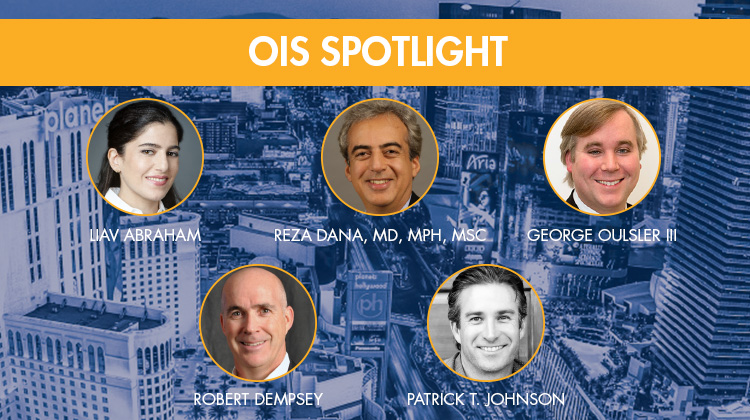2016 Promises to Disrupt Dry Eye

This year promises to deliver disruption to the dry eye disease market as companies work to roll out new drugs, devices, and diagnostics.
Shire may deliver the biggest success. The company is close to bringing a second therapeutic to the market to treat dry eye conditions, as lifitegrast is currently awaiting US regulatory approval. If granted, this will be only the second drug in more than a decade approved to treat dry eye – although a multitude of other compounds made it as far as Phase III pivotal studies or even through to the submission process in the US. One compound, diquafosol, has regulatory approval outside the US, but has failed to gain US Food and Drug Administration approval.
In addition to the new potential drug, a multitude of new diagnostics created to help clinicians better identify ocular surface disease are close to rolling out, according to a panel of dry eye experts at a breakfast session at OIS@AAO. Researchers and clinicians are investigating new compounds, hormonal treatments, and nutritional supplements.
Panel participants noted that the FDA has slowly been moving away from its staunch determination that new compounds must exhibit improvement in both signs and symptoms of dry eye to one that is evaluating “more of a totality of the data,” said Reza Dana, MD, MPH, MSc, Claes Dohlman Professor of Ophthalmology at Harvard Medical School.
Dry eye remains a concern throughout every specialty in ophthalmology, and topical cyclosporine cannot address all aspects of dry eye nor every patient who has dry eye. As a result, expect to see more “one and done” symptoms in upcoming and current trials become a standard measurable threshold for regulatory approval.
One of the reasons there’s been a slow movement away from both signs and symptom improvement is that dry eye can be caused by aging, androgen deficiency, autoimmune disorders, or can be self-created by contact lens wear and/or refractive surgery.
Typically, Phase III studies are where companies will parse out and address a particular sign or symptom, said Patrick T. Johnson, VP of business development at Allergan. Johnson said evaluating a dataset includes assessing the method of action (MOA) of a compound and the disease state. In dry eye, there are numerous hypotheses and causal relationships, but once companies have a validated MOA, hitting endpoints should be easier than it has been in this disease state.
(As Shire’s lifitegrast was under regulatory review during this session, Robert Dempsey, vice president and business unit head of ophthalmics, was precluded from addressing any regulatory commentary.)
Even after numerous studies, “we’re still not at a place where we can say this should be the sign or symptom we’re trying to treat,” Dana said. One study will show X, while another shows Y, or can’t replicate the findings from the first study. Large studies are warranted, but do not come cheaply – $40 million to $100 million may not be enough of an investment.
Plus, as researchers are understanding more about the etiology of the disease itself, inclusion criteria are becoming more stringent – long gone are the days when 100 screened patients meant 100 enrolled patients. These days, enrollment is more likely to be around 35 to 40 patients/100 screened, said George Ousler III, vice president, dry eye at Ora.
The unmet need is what will continue to drive the innovation and the continued investment, Dempsey said – there are 29 million patients with diabetes and the funding is ample. There are 25 million people with dry eye, and that will attract significant investments. With numerous companies showing promising Phase II results that warrant expansion into Phase III, investors are going to have to evaluate the preponderance of data and the MOA targets, Johnson said. “The datasets have to differentiate themselves and then fit into the next study design,” he added.
It’s all about finding the right signals within the data, Dempsey said. “What’s been done in the past may not suffice in the future.”
The theme “worth hearing” is that there will continue to be multiple approaches to treating dry eye, even within a single company, Ousler said.
“Patients may need more than one anti-inflammatory, as there’s more than one cause of the disorder,” Ousler said, equating treatment with those on several classes of glaucoma medications.
Most ophthalmic patients with chronic disorders are used to multiple treatments, and once other treatments for dry eye enter the market, Dana predicts they will be added to topical cyclosporine, not replace it.
“It’s unrealistic for any of us in this room to think we’re going to have one drug that will treat everyone with this disease,” Dana said.
When patients present with symptoms, the best way to guide therapy may very well be to reevaluate how clinicians view the disease.
Doxycycline has been mentioned and evaluated as a potential treatment for dry eye, but a big concern is the placebo effect, these panelists said. If it were a treatment, a large pharmaceutical company would need to differentiate the compound (as it’s already a generic treatment), and a compounding pharmacy would be unlikely to be of great benefit.
Other potential treatments include high-dose omega-3 fatty acids, but nutritional supplements need hundreds of patients in a trial; the National Institutes of Health recently completed a study on omega-3s for cognitive decline and enrolled more than 4,000 patients. Those enrollment numbers are unlikely for dry eye.
Finally, the panelists suggested incorporating biomarkers as a better metric to measure the characteristics of the disease.
